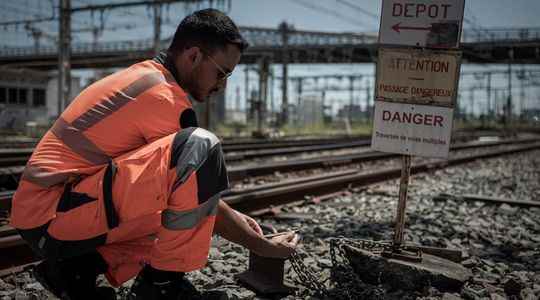With the heat waves that follow one another, it is not uncommon for the SNCF to send a few text messages to its users. “Heat wave alert, possible disruption. Take water if needed,” it read. What disconcert some vacationers, while the link between mercury and rail traffic is not obvious. Fires, expansion of equipment… However, the rail network also suffered from extreme temperatures. What is the operator doing to avoid delays and cancellations, when a fourth heat wave seems to be looming for mid-August? The Express takes stock.
- Prevention messages
When temperatures exceed 35°C, Météo France notifies the SNCF via an alert. This is relayed by the operator so that travelers make their arrangements. We forget it, but a train is not supplied with water. The SNCF therefore recommends bringing water to stay hydrated. The company has still planned a stock of “500,000 bottles of water” of 50 centilitres for 2022, and expects to distribute more. “A million bottles were distributed during the summer of 2021”, she indicates on her website. Moreover, if some trains are air-conditioned, it may be hot in the Transiliens. Only 65% of them are equipped with it.
At the same time, SNCF is working on its infrastructure. “Agents, mobilized day and night, monitor the tracks in order to identify the geographical areas where the temperature is likely to affect the network, even partially”, indicates the company, in an information note for travelers. This staff tracks several climatic phenomena, on foot and through surveillance cameras.
First, the embankment fires. Once identified, they are reported and lead to the intervention of the competent authorities. Essential work to avoid accidents. Last Tuesday, TGV and TER traffic was interrupted in the Landes, between Hendaye and Bordeaux. The fire, which destroyed 32 hectares of pines, was fixed overnight, the Landes prefecture and firefighters said on Wednesday.
- Beware of swollen rails
Heat also poses structural problems. “The rails are made of 95% steel. They expand and lengthen. If this deformation is too great, the trains must limit their speed”, explains the SNCF. Here, the machine assists the man. The SNCF is equipped with a prediction system called “Metigate”. It lets you know in advance which areas of the network are most at risk. Because this phenomenon does not only depend on air temperatures, but also on “cloudiness, sunshine, humidity…”, specifies the operator. In function, the operator may be forced to impose reduced speeds on certain portions.
Tracks aren’t the only devices to fear the heat. Electronic components, present in particular in traffic lights, melt above 65°C. “Air conditioners are installed in the most sensitive technical rooms”, explains the SNCF. Finally, the electrical supply cables of the trains, called catenaries, relax and lengthen with the rise in temperature. Again, this requires the intervention of the SNCF: “to function properly, the power supply cables must be straight. Pulley systems and counterweights keep them always taut.”
The challenge remains to prevent these incidents, so that the network adapts to climate change. Before each summer, the SNCF launches a major inspection. She took the opportunity to clear the area around the tracks to limit the fire. It’s not enough. “Climate change is underway and its first effects have already been observed on the French rail network”, recognizes the company in a document presenting its climate commitments. In addition to the heat, the network must also prepare to undergo more and more bad weather and other natural disasters, while seeing its frequentation increase, because the government pushes for the use of this mode of transport.
The SNCF has already launched a series of studies to measure the consequences. “A new dynamic for adaptation to climate change is being considered within SNCF. The objective is to define the main lines of a roadmap in terms of adaptation, as well as the governance and management of this subject”. What may be redirecting part of the 100 billion euros that the government has promised the group to renovate the network.
